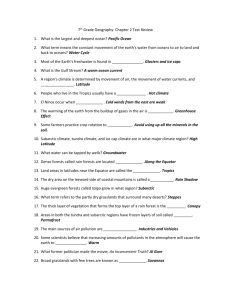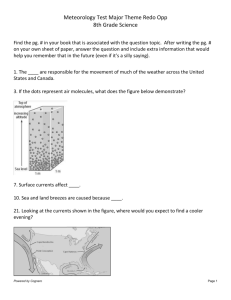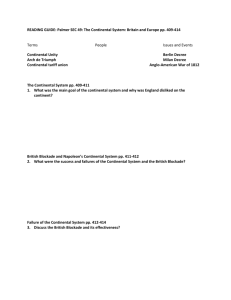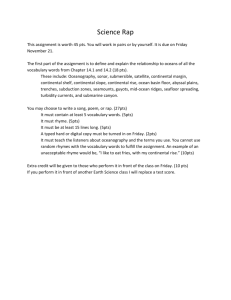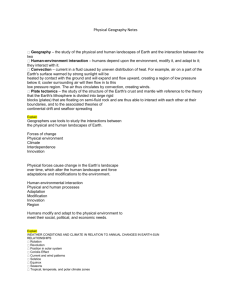HO#7 Temperate Continental only
advertisement
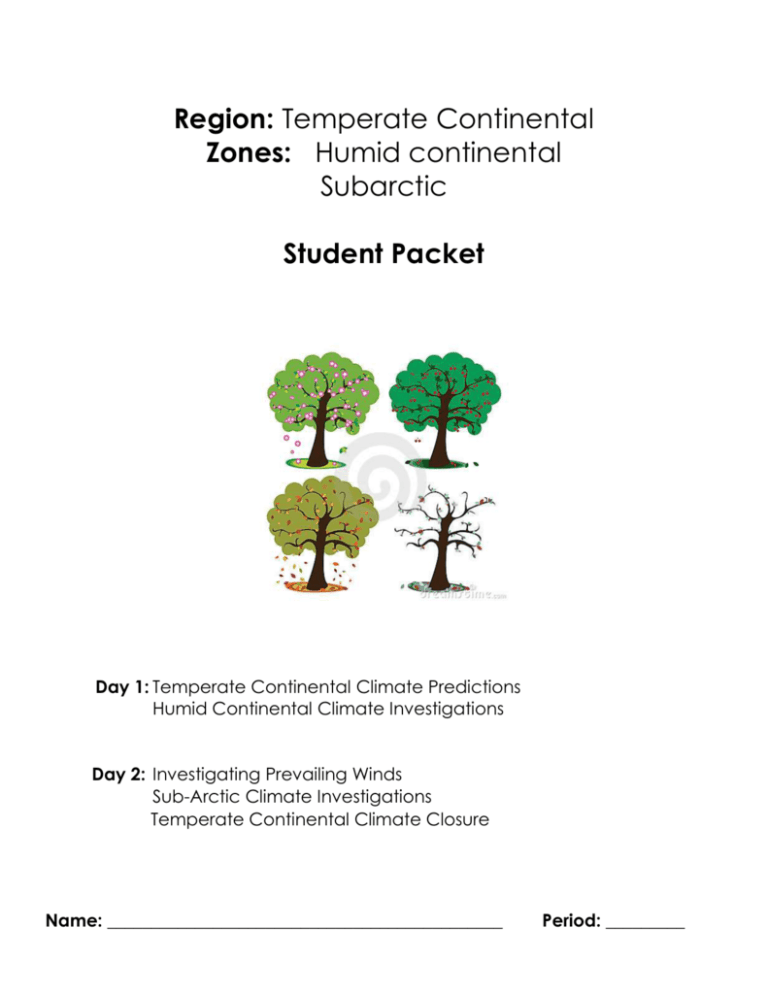
Region: Temperate Continental Zones: Humid continental Subarctic Student Packet Day 1: Temperate Continental Climate Predictions Humid Continental Climate Investigations Day 2: Investigating Prevailing Winds Sub-Arctic Climate Investigations Temperate Continental Climate Closure Name: _____________________________________________ Period: _________ Temperate Continental Climate: Predictions 1. Make a Prediction: Below is a list of characteristics that may or may not be a characteristic of areas located in the Temperate Continental Climates. Circle “yes” for each characteristic that best describes a Temperate Continental Climate area, otherwise circle “no”. If you are unsure of an answer, take your best guess. You will have ten minutes to complete #1-2. Characteristic Part of the Temperate Continental Climate Regions? 1. Weather patterns depend on the winds Yes No 2. Are all found in the Southern hemisphere Yes No 3. Subarctic is known as the Taiga Yes No 4. Are influenced by oceans Yes No 5. Some parts of Humid Continental are grasslands Yes No 6. It is always humid in the Humid Continental zone Yes No 7. Humid Continental has consistent precipitation year round Yes No 8. Subarctic is known for the deciduous forests Yes No 9. Maritime tropical air masses are both warm and dry Yes No 10. Four types of air masses move across this region Yes No 11. Most of the temperate grassland have been converted into farmland Yes No 12. Have extreme temperature differences Yes No 13. Subarctic zone has high precipitation due to little evaporation Yes No 14. Almost all areas in the humid continental zone experience snow. Yes No 15. Humid Continental has a range of temperatures due to the high latitude Yes No 2. In pairs, discuss your choices. Choose at least two of the characteristics above and, using the lines below, describe your reasoning for each choice. Characteristic # ______ Reasoning: ___________________________________________________________________________________ ______________________________________________________________________________________________ ______________________________________________________________________________________________ Characteristic # ______ Reasoning: ___________________________________________________________________________________ ______________________________________________________________________________________________ ______________________________________________________________________________________________ **As you complete this packet, you may correct any incorrect answers above, but please use RED pen/pencil provided in the front of the class. DO NOT erase or cross out any original answers. Temperate Continental Climate Investigation: Comparing the Zones 3. Using text book pages 80 and 89, and the following article, complete the chart. Article: Humid Continental and Subarctic Climate Zones The Humid Continental climate is found in the interior of continents meaning it is not usually found near coasts. This climate is mainly found in the Northern Hemisphere since there are no large landmasses at the same latitude in the Southern Hemisphere. The Humid Continental climate is one of the few climates with 4 different seasons. Warm and humid summers, cool and dry falls, cold and harsh winters, and a warm and wet spring makes living in this zone have a unique variety of weather conditions. The Humid Continental zone has a wide range of temperatures, which means low cold temperatures and high warm temperatures. Summer months average about 70 degrees and winter months usually average 25 degrees. However, summer days can reach over 100 and winter months often reach below zero, which produces a 100 degree temperature range. The main reason for the extreme temperature differences of this zone is latitude. Places that are 40 degrees away from the equator are over 2,800 miles from the equator, this results in less direct sunlight and less warmth. Humid Continental climate has a misleading name. It is not always humid here, but it has enough precipitation to not be considered arid or semiarid. Twenty to fifty inches of rain falls in this climate zone. Almost all areas with this climate experience snow. The moisture is evaporated from the land at a slow, regular pace, which explains why precipitation falls regularly throughout all 4 seasons. A wide variety of plants are found in this region. Evergreen forests are found in the north and mixed with deciduous forests as you move south. Most grasses and shrubs survive here. Some areas of Humid Continental are covered in grassland. These are sometimes called temperate grasslands. This climate is excellent for farming since it has warm summers and regular rainfall. Most of the original grasslands in the temperate region have been converted into farmlands for this reason. The Subarctic climate zone is usually found in the interior (not coastal areas) of high latitude continents since there are few large continents in high latitudes in the Southern Hemisphere, Subarctic climates are only found in the Northern Hemisphere. Subarctic climate zones have 2 seasons. The winter is much longer and extremely cold, with the cool to mild summer lasting only 2-3 months. The summer is sometimes only 1 month long. Since it is found away from the coast, the ocean water doesn't help to warm the land in the winter. The main cause of the temperatures in the subarctic is latitude. Temperatures can reach -40 degrees in the winter and be as high as 85 degrees in the summer--which is the widest range of temperatures of any climate. That would be a 125 degree temperature range. There is very little evaporation in the sub-arctic zone because of the cold temperatures, so very little precipitation falls here. Ten to twenty inches of rain falls in subarctic areas. Most of the rain falls in the summer, when evaporation levels are higher. Subarctic zones are covered in snow for most of the year. The short warm summer melts most of the snow. Not all trees are able to survive the long winters, but evergreen trees such as pine and spruce are hardy enough to survive the cold. Ferns, shrubs and grasses can be found during summer months. The forests of the subarctic climate are often called the Taiga meaning little sticks in reference to the trees found there. The Taiga is the largest land zone in the world since large areas of Russia and Canada are covered in Subarctic Taiga. Taken and adapted from: https://sites.google.com/site/climatetypes/home Define Temperate Continental Climates: __________________________________________________ __________________________________________________________________________________________ Temperate Continental Climate Region General Location of Region Two Subgroups (Zones) Humid Continental Subarctic Location of Zone Precipitation Range of Zone Seasons in Zone 4. Describe the amount of precipitation the humid continental zone receives? ______________ _______________________________________________________________________________________ _______________________________________________________________________________________ 5. What is the reason for the regular amount of precipitation in the humid continental zone? _______________________________________________________________________________________ _______________________________________________________________________________________ 6. What kind of vegetation can be found in the humid continental zone? ___________________ ______________________________________________________________________________________ _______________________________________________________________________________________ Day 2: Investigating Prevailing Winds A huge body of air that has similar temperature, humidity and air pressure at any given height is called an air mass. Air masses bring constantly changing weather to humid continental climates. Air masses can form over land or over water and are either warm or cold. Four major types of air masses influence the weather in North America. They are: maritime polar, continental polar, maritime tropical and continental tropical. Polar (cold) air masses form north of 50˚ north latitude and south of 50˚ south latitude. Tropical (warm) air masses form in the tropics. Continental air masses form over land and are dry while maritime air masses form over oceans and are humid (moist). Directions: Complete the chart by using the following: warm, cold, moist, dry TYPE OF AIR MASS TEMPERATURE OF AIR HUMIDITY OF AIR Maritime tropical Continental tropical Maritime polar Continental polar KEY (m) maritime - forms over water; wet (c) continental - forms over land; dry (P) polar - forms over polar regions; cold (T) tropical - develops over the Tropics; warm 1. Which air masses form over Canada? _______________________________________________ 2. What kind of weather do they bring? _______________________________________________ 3. Which air masses form over the Gulf of Mexico?________________________________________ 4. What kind of weather do they bring?__________________________________________________ 5. What kind of weather would you expect from a maritime polar air mass? ______________________________________________________________________________________ Prevailing Winds Weather patterns depend on the movement of these huge air masses by prevailing winds. In the continental United States, the air masses are commonly moved by the prevailing westerlies and jet steams. Prevailing westerlies are the major wind belts over the United States that generally push air masses from west to east. Jet streams, which are contained within the prevailing westerlies, are bands of high-speed winds about 6 miles above Earth’s surface. As jet streams generally blow from west to east, air masses are carried along their tracks. Use the map on text book pages 84-85 to color in the Humid Continental and the Subarctic zones on the following map. 6. Compare the areas you have just colored on this map to the United States air mass map used in numbers 1-5 on the previous page. Name the air masses that are responsible for bringing weather to these two zones and tell what type of weather they would bring? Zone Air mass name Humid 1. Continental 2. 1. Subarctic 2. Type of weather it brings Source Region Source region is the location from which an air mass originates. An example of a source region would be the icy continental portions of Canada in the winter. As a giant mass of air moves over this source region, the air will acquire the characteristics of the underlying surface. In this case, the air will be dry (continental) and mild to cold (polar). As an air mass stays over a region, it will acquire the properties of that land or ocean region. When air masses move from their source region, they tend to be modified (changed) by the land or water that they pass over. Directions: Read the following articles on Global warming effects in the subarctic zone. Answer the questions that follow each article. Article #1: News Alert to Climate Alarmists: Most Arctic Species Will Benefit From Global Warming This article has been modified from the following website: http://www.forbes.com/sites/jamestaylor/2013/01/02/news-alert-to-climatealarmists-most-arctic-species-will-benefit-from-global-warming/ A team of scientists report that global warming will benefit most Arctic and Subarctic species. According to the scientists, global warming will allow most of these species to expand their ranges, and no species are expected to go extinct. Ecological and environmental scientists in Sweden began their study assuming Arctic and subarctic species would be particularly susceptible to present and future global warming. They first believed that the area of temperate climates will extend further north, affecting species inhabiting northern environments. Consequently, species at high latitudes, such as subarctic zones, should be especially susceptible to climate change, likely experiencing a significant decrease in their areas to roam. Moreover, global warming activists have raised particular concern about species in Arctic and subarctic Europe. It is supposed that the large expected climate change at high northern latitudes therefore makes species in (sub)arctic regions particularly susceptible, especially the European part of the sub-arctics, since this region is the most geographically complex. After modeling the effects of global warming in European high latitudes, however, the scientists reported that global warming alarmists are entirely wrong about the impact of global warming on Arctic and subarctic species. In reality, global warming is likely to benefit most Arctic and subarctic species. Contrary to these expectations, our modeling of species distributions suggests that predicted climate change up to 2080 will favor most mammals presently inhabiting subarctic Europe,” the scientists reported. According to the scientists, “most species will benefit from climate change, except for a few cold-climate specialists.” The reason they expect global warming to benefit Arctic mammals rather than hinder them, they say, is that most high-latitude species are generalists: they’re used to having to cope with a wide range of climatic conditions and aren’t too dependent on any one feature of the ecosystem. Think of the North American beaver, a hardy creature, compared to, say, koalas, who wouldn’t make it far without their eucalyptus trees. The specialists like the Arctic fox, the Norway lemming, or the wolverine, they say, may not do so well. But they also don’t expect them to go extinct. Importantly, no species will go extinct, the scientists report. “Our results indicate that most species (43 out of 61) will expand and shift their ranges, mostly in a north-easterly direction, in response to expected climate change if we assume that species are able to colonize all areas that become climatically suitable,” the scientists observed. Most species will dramatically expand their ranges as the climate warms, the scientists discovered. Accordingly, global warming will enhance rather than restrict biodiversity. “We further predict that the climate in (sub)arctic Europe will become suitable to ten more mammalian species. …Thus, mammalian species richness in sub-arctic Europe is likely to increase substantially.” “When we assumed that species will not be able to disperse beyond areas that are currently suitable for them, we found that the vast majority of species will likely lose part of their geographic range, but none is predicted to go extinct. They suggest that in planning for the future, the best bet for preserving Arctic and subarctic mammal species will come in making sure that there is enough connected habitat for the animals to migrate within, giving them a chance to move freely as the climate shifts. Global warming activists frequently point to Arctic mammals as being particularly susceptible to global warming, but the scientists reported Arctic mammals will be among the greatest beneficiaries of Arctic warming. We also provide evidence that for most subarctic mammals it is not climate change per se that will threaten them, but possible constraints on their ability to move to new areas and changes in what organisms make up the new communities. “In contrast to the general belief that species inhabiting the subarctics will face increased levels of stress due to climate change, our work suggests that the climate in subarctic Europe will improve the future conditions for most of its mammalian species. Warmer and wetter conditions favor more species,” the scientists concluded. APPLY: Find the underlined sentence in the above article. Read it again. Question: If the subarctic Taiga is clear cut, how will this impact the future of some subarctic mammal species? Have the scientists in this article taken this into consideration? Explain. ____________ ________________________________________________________________________________________ ________________________________________________________________________________________ ________________________________________________________________________________________ ________________________________________________________________________________________ ________________________________________________________________________________________ ________________________________________________________________________________________ ________________________________________________________________________________________ Article #2: New Study: As Climate Changes, Boreal (Taiga) Forests to Shift North and Relinquish More Carbon Than Expected News Releases Dan Krotz 510-486-4019 • MAY 5, 2013 This article has been modified from the following website: http://newscenter.lbl.gov/2013/05/05/boreal/ Big changes could be coming to boreal forests, according to new research that maps how climates could shift as temperatures rise. (Image from Wikimedia Commons) It’s difficult to imagine how a degree or two of warming will affect a location. Will it rain less? What will happen to the area’s vegetation? New research offers a way to envision a warmer future. It maps how Earth’s myriad climates—and the ecosystems that depend on them—will move from one area to another as global temperatures rise. The approach foresees big changes for one of the planet’s great carbon sponges. Boreal (Taiga) forests will likely shift north at a steady rate this century. Along the way, the vegetation will give up more trapped carbon than most current climate models predict. The research is published online May 5 in the journal Nature Geoscience. Boreal(Taiga) ecosystems encircle the planet’s high latitudes, covering parts of Canada, Europe, and Russia in coniferous trees and wetlands. This vegetation stores vast amounts of carbon, keeping it out of the atmosphere where it can contribute to climate change. Scientists use incredibly complex computer simulations called Earth system models to predict the interactions between climate change and ecosystems such as boreal (Taiga) forests. These models show that boreal (Taiga) habitat will expand toward the poles in the coming decades as regions farther north of them become warmer and wetter. This means that boreal (Taiga) ecosystems are expected to store even more carbon than they do today. But the research tells a different story. The planet’s boreal (Taiga) forests won’t expand towards the poles. Instead, they’ll shift toward the poles. The difference lies in the prediction that as boreal (Taiga) ecosystems follow the warming climate northward, their southern boundaries will be overtaken by even warmer and drier climates better suited for grassland. And that’s a key difference. “I found that the boreal (Taiga) ecosystems ringing the globe will be pushed north and replaced in their current location by what’s currently to their south. In some places, that will be forest, but in other places it will be grassland,” says Charles Koven, a scientist who conducted the research. The most dramatic changes occur in the higher latitudes. Here, boreal (Taiga) ecosystems will have to race poleward in order to keep up with their climates. They’ll also be influenced by warmer climates from the south. By the end of this century, a forest near Alberta, Canada will have to move 100 miles north in order to maintain its climate. And it will gain a climate that is now located 100 miles to the south. Forests can’t adapt this quickly, however, meaning that in the short-term they’ll be stressed. And in the long-term they’ll be forced to move north and give up their southern regions to grassland. This research was supported by the U.S. Department of Energy’s Office of Science. Apply: Complete the following Look at the map on the bottom of the page. The areas that are outlined represent the subarctic and the northern Taiga (Boreal) forests. Use the map to show how these zones will change according to the scientific research model described in the article. You can use arrows, new boundary lines and word labels to indicate the changes. You will also need to include the new areas of grassland. Name: __________________________________________________________ Period: ________________ Temperate Continental Climates: Closure 1. Closure: Congratulations, you have completed your two-day study of Temperate Continental Climates. It is time to show off all that you have learned by complete the following chart. Below is a list of characteristics that may or may not be a characteristic of areas located in the Temperate Continental Climates. Circle “yes” for each characteristic that best describes a Temperate Continental Climate area, otherwise circle “no”. You will have ten minutes to complete #1-2. Characteristic Part of the Dry Climate Regions? 1. Weather patterns depend on the winds Yes No 2. Are all found in the Southern hemisphere Yes No 3. Subarctic is known as the Taiga Yes No 4. Are influenced by oceans Yes No 5. Some parts of Humid Continental are grasslands Yes No 6. It is always humid in the Humid Continental zone Yes No 7. Yes No 8. Humid Continental has consistent precipitation year roundis known for the deciduous forests Subarctic Yes No 9. Maritime tropical air masses are both warm and dry Yes No 10. Four types of air masses move across this region Yes No 11. Most of the temperate grassland have been converted into farmland 12. Have extreme temperature differences Yes No Yes No 13. Subarctic zone has high precipitation due to little 14. evaporation Almost all areas in the humid continental zone Yes No Yes No snow. has a range of temperatures 15. experience Humid Continental due to the high latitude Yes No 2. Choose at least two of the characteristics above and, using the lines below, describe what evidence you used to confirm that your answers were correct. Characteristic # ______ Evidence: ____________________________________________________________________________ _______________________________________________________________________________________ _______________________________________________________________________________________ Characteristic # ______ Evidence: ____________________________________________________________________________ _______________________________________________________________________________________ _______________________________________________________________________________________

